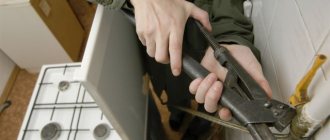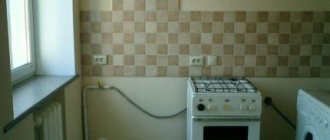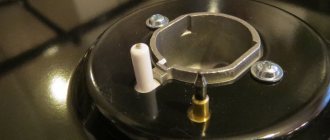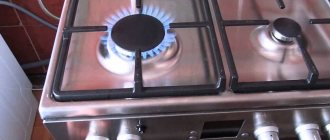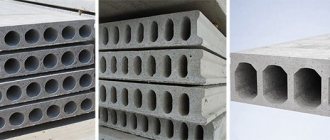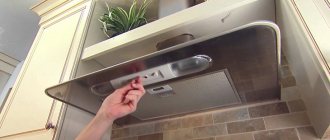Exhaust devices have individual performance, which depends on many factors. One of them is the height of the hood above the gas stove. Correct installation and connections will bring the greatest benefit from the operation of the equipment, so it is important to consider in this article the basic criteria for marking the location and find out at what distance from the stove to connect the hood.
Also, today we will look at the principles of selecting the distance of each type of hood - from horizontal to inclined devices, and also give examples for each type of device.
Types of kitchen hoods
Hoods are used to forcefully remove combustion products, various impurities (nitrogen oxide, carbon dioxide, various carcinogens) and unpleasant odors that appear in the air during cooking. This system operates on the principle of a vacuum cleaner.
A standard hood consists of the following elements: housing, electric motor, air intake, ventilation system, grease (sometimes carbon) filters.
An island hood is an ideal solution for large kitchens, as well as wide stoves and hobs. In this situation, it is important to take into account the height of the cook
Depending on the method of removing processed air, devices can be either circulating or flow-through . In the first case, the air, after purification and filtration, again enters the room, and in the second, it is discharged outside. Circulating ones are suitable if there is no ventilation in the house.
Not long ago, hoods began to appear that combine these two air handling technologies.
There are several types of hoods based on the installation method. Island ones , they are mounted on the ceiling. Corner ones are fixed in the corner of the kitchen. Such models are suitable for small kitchens.
As for installation, the built-in hood model can be easily hidden in a wall cabinet. Dome ones are mounted on the wall. They perfectly complement the interior, but often come in large sizes.
The built-in hood is suitable for kitchens of any size. It is mounted in a special cabinet. Furniture for this purpose is made to order or existing furniture is remodeled.
Factors influencing the distance between the stove and the hood
The hood located above the stove should draw in all the air and steam and not be heated by the burners and pots and pans standing on them. The distance from the slab is determined by calculation and experiment. The main factors influencing the right choice:
- unit power;
- principle of operation of the hood;
- hob type.
The distance between the hood and the gas panel according to GOST is 65–85 centimeters. Above the induction stove, the ventilation equipment can be lowered lower, to a distance of 60–80 cm.
A color scheme
Horizontal appliances, domed and flat, must hang exactly in the center of the stove surface and be at least as wide as the hob.
The width of the lower plane of the air intake is determined by the power of the air-purifying equipment fans. The dimensions of the slab must be taken into account. The vertical deviation from right angles can be within 5–10° to the side of the air intake.
A large ventilation device will interfere with cooking. With lower parameters, there will be no vapor capture on the sides, as a result of which the vapor will partially remain in the room. Or the fans will have to constantly operate at maximum loads. Therefore, the hood should be selected with the required power for the given volume of the kitchen.
Electric stove
The standards for the power of the hood relative to the volume of the kitchen and its minimum distance above the hob are developed with the condition of maximum absorption by the equipment of the ventilation system of the air that rises above the stove during cooking.
At the same time, the air purifying device should not be heated by the burners. If you hang the hood low over the gas stove, the heat from the burners will be added to the heat generated by the ventilation mechanism during operation, so the equipment will quickly overheat and fail.
The design of kitchen hoods also influences the minimum distance. Vertical and inclined ventilation panels are mounted behind the stove; their distance from the upper edge of the stove is reduced to 35 cm, since the lower edge is not located directly above the burners, but is mounted behind the panel at a certain distance.
Bright hues
At what distance should the hood be installed?
The sanitary standard and the technical passport for the equipment determine the distance from the gas stove to the hood - at least 65 cm. This is the manufacturer’s standard. The maximum distance from the gas stove to the cabinet with built-in ventilation is 85 cm, but it is a recommendation. It can be increased by installing more powerful equipment, and thereby ensure complete air purification.
Recommended distances
The minimum distance from the hood to the stove with electric burners, without an open flame, is 5 cm less. Filtration method: recirculation or with outlet to ventilation, this does not affect the established norms of the lower horizontal.
Built-in horizontal models are installed at a distance specified for wall-mounted and hanging models, namely: from electric stoves - at least 60 cm, from gas stoves - 65 cm.
Air filter location diagram according to standards
It is necessary to take into account
To correctly calculate the distance from the hob to the air intake, you need to consider:
- power;
- Type of equipment;
- location of the air intake plane – inclined or horizontal;
- type of stove;
- the height of the hostess.
At what distance to hang a kitchen air filter above the stove depends on the power of the hood. When installing low-power circulation-type models, maintain the minimum permissible distance. They are suitable for kitchens up to 10 m2.
Basic rules and regulations
Fireplace hoods can be hung higher than recommended by standards. Such models are characterized by a large air intake area, high performance and power. They have 4 fans that drive the air flow through the filters and discharge it into the exhaust duct. At the same time, the cleaning of a kitchen of any size and the dining room combined with it is carried out efficiently. Not only above the stove, but also from the entire room, air with soot, grease and steam is discharged into the exhaust system.
Recirculation-type installations filter air masses and return them in purified form back to the kitchen. They are suitable for small rooms where it is difficult to provide air flow from outside. In fact, only mechanical impurities and water remain on the filters. Carbon dioxide comes back. Oxygen levels in the air remain low.
Before choosing an air filter model, you should consider the size of the kitchen. It is also necessary to correctly determine its location. It is important at what distance from the stove the ventilation equipment is installed. The power of the device is determined by the volume of air in the room where it is installed.
Options and standards
Experts recommend purchasing hoods with one fan for small rooms; its operation is sufficient to clean the kitchen 10–12 times per hour.
The location of the bottom horizontal of the device is selected to be minimal for the existing hob.
The volume of a large room requires powerful equipment. The ventilation device in the kitchen is hung at the maximum distance from the stove surface recommended in the technical data sheet of this model.
Standard sizes
For ease of use of the equipment, the installation of a hood in the kitchen is carried out taking into account the height of the housewife. The front edge of the panel should not touch the head when a person leans over food being prepared on the stove. You shouldn’t hang the hood very high above the stove; it’s enough at the level of a raised half-bent arm. While cooking, you can easily switch ventilation modes without distraction.
Ergonomics experts recommend positioning the hood taking into account the height of the person who stands most near the stove. They calculated the most convenient size of the filter device from the floor of the bottom panel at a distance: human height minus 35 cm. The standards established by GOST should not be violated; they are based on the safe operation of the equipment.
Watch a useful video on this topic below.
DIY installation - basic steps
For those who are used to carrying out repair and installation work on their own, you can install a ventilation system by going through three stages of work:
First step
The first step involves preparing the premises for the start of work. If there is no ventilation hole at the installation site, then it is necessary to make one.
After the hole is prepared, it is necessary to proceed with the actual fastening of the ventilation system. Installation features depend on the type of hood being mounted
It is important to do this efficiently so that there are no misunderstandings during operation.
Second step
If the installation body does not have enough holes for mounting, you can make them yourself. Having completed the installation, you can proceed to connecting to the central ventilation system.
It should be remembered that for smooth operation you need a channel for removing air masses and a stable power supply.
High-quality connection work will allow the system to operate for a long time without failures. However, the installation work did not end there. All that remains is to launch the system and improve its appearance.
Third step
Having completed the work, you need to check the build quality; to do this, you need to check all operating modes of the device in test mode.
The backlight is turned on, the noise level is measured, which must correspond to the indicators specified in the attached instructions. If all standards are observed, you can use the device without fear of it breaking.
It is not always enough just to install the system: if the device is located at a fairly large distance from the entrance to the shaft of the central system, then the connection must be disguised so that the interior of the room does not suffer because of it.
Over long distances, this can be quite expensive, so it is worth considering the design of the camouflage before planning the costs.
Calculation of the minimum required exhaust power
Before purchasing a new device for air purification in the kitchen, you should make some measurements and calculations in order to know exactly what power equipment will be able to efficiently purify the air in the kitchen.
Before purchasing a kitchen hood, it is necessary to accurately determine the volume of air in the ventilated room. Then make the calculation yourself. You can contact the seller with these measurements. It will determine the performance of the equipment. The minimum required power is determined by the formula:
Pb = Vk × 12 × 1.3 = (a × b × h) × 12 × 1.3
Where:
- Vk = (a × b × h) – kitchen volume;
- The air must be completely changed 12 times in 1 hour;
- 1.3 – actual power coefficient, it takes into account power losses when air passes through ventilation holes, filters and pipeline bends;
- Pb – design hood power.
All necessary measurements and power calculations can be made independently. It is enough to determine the length and width of the kitchen, as well as its height, using a tape measure. The numbers are written in meters. Then calculations are made using a simple calculator. By multiplying three numbers, you get the volume in cubic meters (m3). When multiplied by other coefficients, the resulting power is m3/hour.
Scheme and drawing
Model performance does not always match estimates exactly. The nearest higher value should be selected. A less powerful device costs less. But it will constantly work at maximum load, as a result of which it can quickly fail. There is also a possibility that the air will not be completely purified, and then odors will penetrate into the rooms.
Equipment with air exhaust into ventilation usually has high performance. It can be installed above an electric stove above the standard size. As a result of powerful exhaust ventilation, the kitchen and even living rooms will be completely cleaned not only from steam and grease.
Ventilation with exhaust to the outside removes moisture, carbon dioxide, and unpleasant odors from the apartment. The peculiarity of exhaust ventilation is that for its normal implementation it is necessary to ensure access of air from outside into the apartment.
Accounting for distances from the slab according to standards
You cannot install powerful equipment above a gas stove and hang it at a minimum distance from the heating elements. A close hole with a large air flow can blow out the burner flame.
Pipe transfer
The decision whether it is possible to cut or move the gas pipe in the kitchen will be up to the relevant services. You are only free to propose network redevelopment and voice your option. And professionals will tell you whether such changes are real, whether they will pose a threat to people’s lives, and will also tell you how much such an “upgrade” will cost you. Where to begin? Where should I knock?
Registration of permission
Remember the step-by-step instructions for preparatory actions and coordination of plans for moving gas pipes:
- Contact the gas service according to the place of registration. It happens that you need to “knock” on some subsidiary structure of this organization: they will explain everything to you on the spot.
- Filling out an application. You will be provided with a sample application, on the basis of which you must write statements on your behalf on what changes you want to make (the application serves as the basis for a specialist to visit you).
- Inspection of the home by a gas service representative. The master will listen to you, examine everything, check it, make the correct calculations (taking into account compliance with all standards). It is not a fact that the expert will reject your plan; it happens, especially with a diligent approach and the homeowner studying the rules, that the master does not have to edit anything.
- Drawing up an estimate. This is, in fact, what the office you contacted does.
- Coordination of the estimate. When the plan is ready, it will be given to you so that you can read the documents and give your consent to carry out this type of work.
- Payment. If you are satisfied with the estimate, you should pay for this service. If not, then don’t be upset, it can be improved, you just tell the master what you don’t agree with, and he will find a compromise offer.
Worth paying attention! If it is not possible/safe to make the network configuration according to the “scenario” you propose, or the estimate proposed by the service does not suit you, then it is too early to give up. Buy or order a beautiful box for the gas pipe in the kitchen, and your problem will be solved and the beauty will be increased.
Preparation for the process
If you agree on the estimate, then within 5 days (usually) a team will knock on your house, ready to move the pipes according to your wishes. Do you need to prepare for the arrival of the masters? If you want the work to be carried out quickly, efficiently, and your home not to be damaged by the workers’ visit, you should do the following:
- contact the craftsmen and find out if you need to provide any consumables (so as not to run after them while the team is working, frantically looking for someone of your own who will look after the apartment, after all, strangers are working);
- free up the space where it is planned to dismantle and install new pipes - workers must have unhindered access to the network;
- cover all kitchen surfaces, appliances and other valuable items, because the craftsmen will be cutting, cooking, dusting and littering (it is better to use coatings that are not prone to burning as a material, for example, tarpaulin, burlap);
- close the valve to stop the flow of blue fuel to the pipes.
(2 ratings, average 4.5 out of 5)
Device installation rules
The hood, which filters the air and returns it back, is easy to install. You can install it above an electric stove yourself.
- It is necessary to draw a horizontal line above the hob at the height of equipment installation - the distance between the gas stove and the hood.
- A vertical line is drawn on the wall in the center of the slab. The standard provides rules for installing the hood exactly above the hob.
- The template from the packaging is applied to the lines, and 4 points are marked - the locations of the mounting bolts. Depending on the model, the distance between them is set as standard 200×200 or 200×100 mm.
- Make holes, hammer in dowels and screw in screws.
- The design without a filter grille and housing is hung on the wall.
- Install the remaining parts of the mechanism.
Spacious kitchen with electric stove
In cases where you purchase a hood with air exhaust into a ventilation pipe or chimney, the structure itself with fans is mounted on the wall in the same way as a model with a circulation method of air purification. Then you need to install the air duct, taking into account the minimum distance from the hood to the gas or electric stove. For normal ventilation, in order to prevent the effect of recirculation, that is, the return of air masses from the ventilation ducts back into the pipe, it is advisable to invite specialists.
Basic requirements for the air duct:
- the cross-section of the pipe is designed to allow air masses to pass through it at maximum equipment performance;
- the safety factor is taken into the formula for a specific design;
- the optimal distance to the outer wall or ventilation duct should be no more than 5 m;
- a maximum of 3 bends are allowed in the duct;
- pipes of different sections are unsuitable for the exhaust structure;
- All turns are made smooth, from radii.
At the stage of planning the placement of equipment in the kitchen, the stove should be placed closer to the outer wall or opposite the ventilation ducts in an apartment building.
Kitchen with gas stove in a country house
The socket must be grounded and located on the side of the edge of the hood body at a distance of 25 cm. The safest option is to install a switch that can quickly turn off the equipment.
How does it work?
The principle of operation of the hood is quite simple and similar to ventilation. When you turn on the device, you can remove fumes, unpleasant odors and fumes from the room. In order for the hood to quickly cope with the task, its structure includes special filters, which should catch any contaminants. Another feature of the structure is forced ventilation, which is turned on for effective air exchange when the amount of pollution exceeds clean air masses.
Additional functions will be good helpers for any housewife, so it’s worth choosing a model that will create optimal conditions for working in a small room
When choosing a hood for the kitchen, it is worth studying its internal structure, paying special attention to the filter system. According to this criterion, there are two types of device:
- recirculation - allows you to clean the air from dirt and grease through filters, after which the same air mass is returned to the room;
- flow-through - thanks to it, the air is purified, which is drawn in from the kitchen and released outside the apartment using ventilation.
The flow hood should be connected to the general ventilation of the house. Thanks to the presence of an air duct, this process is carried out conveniently and quickly. Access to clean air occurs through windows or air masses coming from other rooms. A recirculating hood has no connection with ventilation, so the same air circulates in the kitchen, being cleaned thanks to the device. To ensure that air masses are drawn in and out efficiently, the hood has a powerful motor.
The choice in favor of one type or another will help to make a ventilation duct, which is available in any kitchen of a multi-storey building. If it is located near the cooking area, then it makes sense to install a flow-through hood, but if it is far away, then a recirculation one. If the house is very old, the ventilation may be clogged and air will pass through it with difficulty, in which case it is also worth using a recirculation device or purchasing a combined one that can work in both directions.
This option includes both an air duct and filters that can be used seasonally. For the winter period, it is better to use the circulation principle so as not to cool the room, and in the summer use an air vent.
Depending on the appearance of the hood, it can be installed on the ceiling, wall or built into the kitchen unit. Ceiling and wall variations usually have a design that allows you to make this device organic and easily fit into the room.
General recommendations for safe installation
But in order for any model of hood to work efficiently and fulfill its functions, it must be installed correctly. This task is best left to professionals.
So, the following factors influence the height of the hood:
- standard recommendations;
- type of stove or hob;
- the presence or absence of ventilation, as well as its power;
- device performance;
- hood dimensions;
- user height.
Since the main task of the device is to purify the air above the hob, when calculating the height you should base it, first of all, on the type and size of the stove itself.
There are stoves: gas, electric, induction and halogen. A special feature of the latter are Hi-Light burners.
To operate effectively, the hood must completely cover the hob area. Thanks to this, all polluted air will be recycled. If the stove is wider, then harmful impurities and unnecessary odors will remain in the kitchen.
For fire safety reasons, standard height parameters between the hood and the burners have been developed.
When compiling them, the type of stove and the design of the lower part of the hood are taken into account. It can be straight or inclined.
For gas stoves, the height from the burners to the straight hood is from 75 to 85 cm, and to the inclined hood – 55-65 cm.
For electric, induction and halogen surfaces, the height from the burners to the direct hood is from 65 to 75 cm, and to the inclined hood – from 35 to 45 cm.
This difference in height is explained by the absence or presence of open fire and the risk of ignition of fat and soot particles on the filters
Often the manufacturer himself prescribes the required height. This is dictated by the characteristics of the materials from which the filters and the device itself are made. The material may be particularly flame resistant and/or have some special features.
You can deviate from the established standards by a maximum of 5-10 centimeters. The distance can only be increased, and reduced only if the power allows and the height of the cook requires it. In any case, before making a final decision, you should consult a specialist.
Professional installation will allow the device to perform its functions better and more efficiently (to extract all excess and purify the air), and will also save energy, since you will not have to turn on the hood at maximum power.
In addition, the height between the hood and the hob is affected by the performance of the hood itself. Sometimes this indicator is called power and is measured in cubic meters. m/hour. Before purchasing a hood, it is worth calculating at least an approximate value.
The quality of air purification directly depends on productivity. Also, if the device has sufficient power, you can adjust the height of the hood above the hob.
It is worth noting that power is also affected by the presence or absence of ventilation and the number of family members who smoke. Additional creases and right angles of the duct can only reduce the performance and increase the noise of the hood
No. 1 - installing a hood over a gas stove
There are many requirements for appliances that are installed above a gas stove. First, you need to accurately measure the distance from the bottom of the device to the hob. As mentioned above, it should be within 75-85 cm.
This distance is slightly greater than when installing the device above an electric model due to the fact that an open flame can ignite the hood filters, especially if they are heavily dirty.
Also, we should not forget that in the case of gas stoves, natural ventilation must work. Therefore, during installation, you cannot completely block the ventilation hole in the kitchen.
To avoid this, you can purchase special grilles for air ducts, divided into two parts: one for connecting the hood, and the other for natural ventilation.
The extraction power is also a very important parameter. Before purchasing a unit, it is necessary to accurately calculate it. A little below will be written about how to do this correctly.
Having carried out the necessary calculations and measurements, it is worth remembering that you cannot buy a device with less power than that obtained in the calculations. Otherwise, it will just be money thrown away; such a device will not cope with the task assigned to it
Do you want to install a hood over a gas stove yourself? In this case, we recommend watching the step-by-step installation instructions.
No. 2 - distance to the electric stove
More lenient requirements are being put forward for electric models. First of all, this concerns the installation height of the hood above the device - it can be reduced slightly, since these models are considered safer to use than gas models.
If the kitchen space is small, then the best option would be to opt for a built-in or flat hood model. In addition to convenience, the prices for such devices are affordable for most citizens.
Another important factor that needs to be taken into account when placing the device above the hob is the dimensions of the stove. So, the width and length of the hood should not be less than the same parameters of the slab. Otherwise, grease and soot will accumulate on the furniture.
The hood above an electric stove can be placed a little lower than above a gas stove, since the former are a little safer to use
Kitchen ventilation
An anti-return valve is present in a modern kitchen ventilation system.
What does “good ventilation” mean in the kitchen? It is clear that a modern kitchen is a whole set of kitchen appliances that makes it easier for the housewife to prepare food. This includes: stove, oven, microwave, toaster, multicooker, bread maker and other “helpers”. To prevent various odors from entering other rooms from the kitchen, you need to equip it with a high-quality ventilation system. It can be general or local.
- The general exchange provides air exchange throughout the kitchen. It can be supply, exhaust, supply and exhaust and is aimed at removing odors, burning, and excess moisture.
- Local – rids the room of odors from the immediate area. For the kitchen area, this is a hood that is installed directly above the hob. A device such as a kitchen umbrella is often installed in private homes where there are large kitchen areas or they are connected to the dining room, or where food is often prepared.
Important! Whatever type of ventilation is chosen, it is necessary to remember its supply and exhaust purpose. That is, when arranging a hood, take care of the flow of fresh air.
General requirements, rules and standards for installing hoods
There are general rules that should be followed during the installation of any exhaust systems. The main thing is compliance with the manufacturer’s requirements and established standards. The instructions for any model always contain recommendations on the optimal distance to the stove. As a rule, you can vary these parameters within 10 cm depending on the height of the housewife or the characteristics of the furniture design. The standards were developed to prevent fires to maintain fire safety. The width of the hood must match the width of the hob. If the suction surface is smaller than the area of the stove, effective air purification will not occur.
Installation features and height above the gas stove
Of all types of stoves, it is the gas stove that puts forward the most serious requirements for the installation and placement of the hood. It is unacceptable to ignore standard recommendations, since their failure to comply creates a real threat to the lives of both the individual family and the other inhabitants of the building.
Let's start with the fact that using a gas stove implies the presence of an open fire in the room. Any devices and structures placed above them must be removed from the surface at a distance of 75-85 cm.
When installing the air duct, you must remember that it is unacceptable to completely close the ventilation hole. Gas accumulated in the room as a result of an accident or improper handling of the stove must be able to escape freely. If a separate outlet to the ventilation duct is not provided, the existing one should be divided into two parts. This is achieved by installing a special grille divided into two sections. In one part there is a hole for the pipe, the second has standard jumpers.
Installation features and height above electric and induction hobs
The requirements for installing hoods over electric and induction hobs are somewhat milder. This mainly relates to recommendations for placing the device at a certain height above the stove. In this case, it is allowed to install the hood a little lower - at a distance of 65-75 cm.
Installation features and height of inclined hood
Inclined hoods are indispensable in miniature rooms, where the issue of maximizing the preservation of free space is acute. When installing an inclined hood over a gas stove, the requirements are slightly different. The lower edge of the surface should be at a distance of 55-65 cm from the gas oven. You only need to step back 35-45 cm from an induction or electric stove.
Design advantages
Typically, an inclined hood is distinguished by greater power and productivity. This is due to the peculiarities of its functioning: air is drawn in during the process of natural rise, without excessive energy consumption. More powerful motors, efficient cleaning filters, together with the angular location of the air intake, make kitchen hoods an excellent choice with many other advantages:
- they are more convenient to install, do not limit the use of wall cabinets installed nearby, and allow their doors to be opened freely;
- increased efficiency of air exchange allows you to quickly remove unpleasant fumes and odors from the room, even in comparison with the most powerful analogues of other types;
- the advantage of air exchange results in savings on electricity, which becomes noticeable with frequent use of the device;
- the use of more advanced electric motors reduces noise and ensures their quietest operation in comparison with other types of models;
- design features ensure ease of installation, which does not require special skills and a complex set of tools;
- such devices are more ergonomic, they are comfortable when working near the stove, and create conditions for convenient access to the entire space of the hob;
- Thanks to its modern design and wide range of models, it looks great in the interior of any kitchen.
Requirements for air ducts and electrical networks
Parameters such as air ducts and electrical networks directly affect the performance of exhaust devices. That is why it is necessary to take a responsible approach to the design of ventilation ducts and electrical networks.
It should be immediately noted that for recirculation type hoods there is no need to lay ventilation pipes. They absorb air and simply filter it, after which they return it back to the room. That is why this chapter will consider the flow-through type of exhaust equipment.
If you do not plan the air exhaust system correctly, a person may get a number of the following problems:
- Changes in pressure in the channels;
- Load on the hood motor;
- Poor air permeability;
- Large air flow from the street.
To avoid this, it is best to use the help of professionals who will install ventilation ducts according to GOST standards. Only in this case will the hood be able to reveal its full potential and not cause problems during long-term use.
Also, attention must be paid to electrical networks. The position of the socket must correspond to the length of the factory hood cable. Under no circumstances is it recommended to extend the equipment wire yourself; this can lead to cable oxidation and overloading the hood.
The socket is also installed in accordance with GOST standards. It is best to plan the wiring and power points in advance after the hood has already been purchased. Of course, you can always use an extension cord.
Where to put the socket
So, in order to correctly design and install ventilation ducts, it is necessary to adhere to the basic opinions of experts, which will help increase the performance of the hood and reduce the pressure on the device’s motor.
The first thing to avoid when laying communications is excessive bends. First of all, they force the exhaust air to create additional pressure in order to deliver the exhaust air outside the house. Hence the conclusion: the fewer knees, the less force the device will need to expend to perform its basic functions. Also, the pipes must be sealed. Under no circumstances should holes be allowed in them, which could lead to a loss of pressure and, accordingly, to overload of the hood motor.
It is important to make the distance from the hood to the street as short as possible so that the exhaust device spends less energy working with a large volume of air. Also, narrowing and expansion should be avoided - the pipe must be of the same cross-section throughout its entire length, which will allow maintaining constant pressure for normal operation of the fans.
It is also recommended to install ventilation communications strictly at level. There is no need to make the air rise at an angle through the pipe; it is better to maintain a strict horizontal line and use a 90-degree elbow to move to the vertical level.
The diameter of the ventilation pipes must match the hood connector. It is best to use pipes made of environmentally friendly plastic or galvanized, they will last longer, and the cost will not hit the budget too much.
It is important to note that the installation of ventilation ducts should be carried out by a specialist who has extensive experience working with hoods and knows the basic subtleties that can improve or, conversely, worsen the performance of the exhaust device.
Distance for ventilation ducts
According to GOST standards, the outlet for the exhaust device is installed at a height of 2.5 meters from the floor level. This is the optimal indicator that specialists will use during the installation of electrical communications.
Also, it is necessary to step back 15-20 centimeters to the left or right from the hood so that the equipment body does not block the access point to the electrical network. Some hoods are connected directly to the network using terminal blocks or plugs, so installing an outlet is not always necessary.
It is very important to provide grounding for the outlet. Grounding prevents the device from burning out due to voltage surges or other unpleasant situations. Considering that some hoods cost a lot of money, it is best to take every precaution and know that the equipment will not be damaged.
If the wiring and sockets are old and the hood is already installed, you can use an extension cord. However, it is recommended to purchase an extension cord with a fuse (a device that will disconnect the carrier from the mains in the event of power surges or other situations).
Self-installation
A hood is not the most complicated device, so if you have a little experience and a set of necessary tools, it is quite possible to install it yourself. Self-installation is a great opportunity to save on the services of specialists.
Installation of a hood attached to the bottom of the cabinet
Hanging models are attached directly to the bottom shelf of the cabinet. Installation is simple, installation is carried out using self-tapping screws and a screwdriver. Since connecting the air duct to the recirculating device is not required, the installation ends by connecting it to the electrical network.
Installation of a hood in a wall cabinet
Installing a hood into a cabinet yourself requires certain carpentry skills. For a new set, the device is purchased at the furniture design stage. In order for it to fit into an already used hanging cabinet, it is necessary that the dimensions of the hood correspond to the internal dimensions of the case.
To work you will need:
- jigsaw, you can also use a manual one;
- hacksaw for wood;
- pencil;
- screwdriver (preferably a screwdriver);
- awl;
- construction angle, tape measure;
- clamps.
Installation steps:
- First of all, you need to free the cabinets from the facades, and not only the specific cabinet for the hood, but also the adjacent drawers. Next, remove the cabinet and fasten the adjacent cases together with clamps. Do not skip this point - the boxes may fall and be damaged.
- We unscrew the bottom shelf and apply it to the upper plane of the exhaust device. We outline the outline of the air duct and the holes for the outlet of the wire with a plug to connect the device to the network. Cut out the marked holes.
- We insert the hood into the housing and mark the upper boundaries of the device. We fasten the bottom shelf along the marked lines. We drill 4 holes in it.
You can ensure exact alignment of the fastening points with the holes using a stencil.
We fix the hood inside the cabinet and install the air duct. We use it to connect the ventilation hole and the system. We install shelves and fronts. It is worth checking the functionality of the equipment before installing the facades.
Installation of a hood with an air duct
The installation procedure for such a hood includes:
- fixing the hood;
- development of air duct and electrical wiring diagrams;
- box fitting;
- installation of the box using sealant.
The air duct is assembled from a plastic box or made of aluminum corrugation. The first option is stronger, more aesthetically pleasing and more reliable. Therefore, it is worth giving preference to it. Plastic is easy to saw and joined with special elements. Additional strength is added to the joints using sealant. Corrugation also has its advantages - its flexibility allows you to lay the air duct along a curved path.
Tips for use
- Keep the device clean and wipe it free of dust and grease after each use.
- Do not turn off the device immediately after cooking, as steam particles can spread throughout the kitchen faster than the device can absorb them. Therefore, you need to leave the hood running for a few more minutes so that it draws in all the fumes.
- Replace carbon filters regularly - at least 2 times a year.

